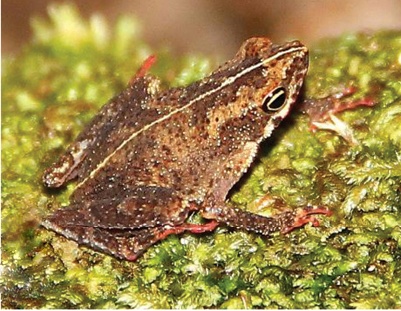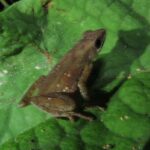- The Mysteries of the Matsés Toadlet: Exploring Amazophrynella matses
- Introduction: Unveiling a Hidden Jewel of the Amazon
- Taxonomy and Classification: A Unique Branch of Frog Diversity
- Natural Habitat: Life Beneath the Leaf Litter
- Physical Characteristics: Tiny Yet Unforgettable
- Behavior and Life Cycle: Intricate Rituals of Survival
- Ecological Role: The Importance of Amphibians as Bioindicators
- Threats and Conservation Status: Navigating Challenges of Modern Development
- Cultural and Scientific Significance: Bonds Beyond Biology
- Conclusion: Preserving a Tiny Gem of Our Natural Heritage
The Mysteries of the Matsés Toadlet: Exploring Amazophrynella matses#
Introduction: Unveiling a Hidden Jewel of the Amazon#
Deep within the lush maze of the Peruvian Amazon rainforest, concealed beneath layers of moist leaf litter and camouflaged by dappled shadows, thrives a tiny amphibian whose peculiarity belies its diminutive stature: the Matsés Toadlet, scientifically named Amazophrynella matses. Named after the Matsés indigenous people, whose intricate cultural bond with their environment mirrors the toadlet’s intimate dependence upon the rainforest’s intricate web of life, this fascinating frog is more than just another beautiful amphibian character—it is an important indicator of ecosystem health, biodiversity, and survival in a rapidly changing world.
With its discovery only as recent as 2012, Amazophrynella matses exemplifies the richness and mystery still hidden within Earth’s biodiversity. Each encounter offers scientists and naturalists alike a captivating window into a unique creature perfectly adapted to its specialized microhabitat, whispering vivid stories about nature’s ingenuity.
Taxonomy and Classification: A Unique Branch of Frog Diversity#
Amazophrynella matses belongs to the Bufonidae family, widely recognized as the “true toads.” Within this family, it is grouped under the genus Amazophrynella, distinctive for their small size, specialized ecological demands, and unique evolutionary traits adapted to Amazonian habitats. The species’ discovery emphasized the extent of biodiversity hiding in even the smallest ecological niches in one of the world’s largest biodiversity hotspots.
Its close relatives, such as Amazophrynella minuta and Amazophrynella bokermanni, share similar cryptic coloration and ecological adaptations, but each holds subtle yet important differences that highlight the rainforest’s incredibly refined evolutionary niches. Understanding the evolutionary relationships within the genus helps conservationists and biologists protect these frogs more effectively, as each species carries unique genetic diversity essential for ecosystem resilience.
Natural Habitat: Life Beneath the Leaf Litter#
Endemic principally to the Loreto region of Peru, specifically within territories inhabited by the Matsés indigenous communities, Amazophrynella matses makes its home in the humid understory of pristine, lowland Amazonian rainforests. Here, beneath dense canopies draped with emerald greenery and vines interwoven like organic tapestries, these tiny frogs prefer microhabitats rich in leaf litter, fallen branches, and shaded pockets of moist soil. Such an environment not only provides shelter and moisture critical to their survival, but also houses abundant insect prey crucial for the sustenance of their population.
Ecological specialists like the Matsés Toadlet are inseparable from their chosen surroundings. The persistent humidity, stable temperatures, and camouflage offered by leaf litter suit the species perfectly, contributing immensely to their survival, reproduction, and population stability. Indeed, the story of this amphibian vividly tells the broader tale of interdependence, specialized ecosystems, and delicate ecological balances.
Physical Characteristics: Tiny Yet Unforgettable#
One could easily overlook this toadlet if not for careful observation. Measuring barely over 15–20 millimeters in length, Amazophrynella matses effortlessly blends into its environment. Its subtle tones of brown, gray, and mottled tans harmonize beautifully with the surrounding leaf litter, effectively cloaking it in invisibility from predators like birds, snakes, and spiders. This perfect camouflage prevents unnecessary predation pressures and enhances survival in a highly competitive environment.
The species displays rough-textured skin characterized by tiny wart-like bumps, typical of many toads within the Bufonidae family, which not only aid camouflage but may also deter predators. Notably, its digits are slender and delicate, suited to agile movements across damp debris. Eye-catching in the sunlight, the eyes of these frogs possess a lustrous golden bronze hue, alert and watchful, attesting to a centuries-old evolutionary wariness toward environmental threats.
Behavior and Life Cycle: Intricate Rituals of Survival#
Feeding and Foraging Strategies#
Predominantly insectivorous, Amazophrynella matses actively hunts small arthropods, such as ants, mites, and beetles, within its leaf litter sanctuary. Utilizing quick, efficient leaps and precise tongue flicks, they adeptly capture prey. Their feeding behaviors, though miniature and fleeting, contribute significantly to controlling insect populations, serving a notable ecological service that supports forest health.
Reproductive Habits: A Delicately Balanced Cycle#
Breeding typically coincides with the rainy season, when increased rainfall ensures abundant and suitable aquatic or semi-aquatic environments for tadpole development. Males issue discreet yet melodious chirps, delicate calls that resonate gently through the humid understory, attracting females ready to spawn. Upon mating, females deposit tiny clusters of gelatinous eggs in carefully selected depressions—usually small, temporary puddles or leaf-lined pools—to maximize offspring survival.
Tadpoles emerge shortly after precipitation events, embarking upon a delicate developmental journey defined by sensitivity to water temperature, predator avoidance, and availability of nutrition. These temporary breeding sites frequently vanish swiftly, requiring rapid metamorphosis—a demanding ecological pressure that underlines the species’ vulnerability and their adaptability simultaneously.
Ecological Role: The Importance of Amphibians as Bioindicators#
Amphibians like the Matsés Toadlet serve crucial ecological roles. Their remarkable sensitivity to environmental changes positions them as frontline bioindicators of ecological health. A sudden decline in their populations frequently highlights broader issues, such as habitat degradation, chemical pollution, or shifts induced by climate change. Conversely, abundant populations indicate a healthy, balanced ecosystem functioning effectively.
As prey, they fulfill crucial positions within food webs, sustaining myriad predators such as snakes, birds, mammals, and spiders. Simultaneously, their predation upon insects moderates arthropod populations, an essential ecological service which underscores their critical ecosystem contributions.
Threats and Conservation Status: Navigating Challenges of Modern Development#
Due to its relatively recent discovery, precise conservation status assessments such as those provided by the IUCN remain limited. Nonetheless, the Matsés toadlet faces threats comparable to many Amazonian amphibians. Habitat fragmentation caused by logging, agriculture expansion, and human settlements poses paramount concerns, as these anthropogenic activities disrupt the specialized microhabitats essential for their survival.
Climate change adds layers of complexity, altering rainfall patterns, temperatures, and resulting availability of breeding habitats. Because they depend heavily upon precise ecological conditions, even minor climate shifts can substantially impact their reproductive success. Long-term safeguarding of the species hinges upon preserving intact rainforest ecologies, proactive habitat management, and supportive community-led conservation initiatives.
Cultural and Scientific Significance: Bonds Beyond Biology#
The naming tribute paid to the indigenous Matsés people underscores a crucial cultural bond connecting this toadlet to local communities who cautiously preserve ancestral knowledge of rainforest biodiversity. Indigenous Matsés tribes revered frogs and toads, recognizing amphibians as crucial symbols of environmental abundance and sustainability.
In scientific contexts, the Matsés toadlet serves as a case study of biodiversity discoveries emphasizing the expansive, untapped potential of discoveries awaiting science in remote regions. Each new amphibian species discovered significantly enriches our understanding of reptile-amphibian evolution, ecological adaptation, and environmental health.
Conclusion: Preserving a Tiny Gem of Our Natural Heritage#
Hidden beneath layers of vivid green canopies and whispered brume, Amazophrynella matses symbolizes far more than biological diversity—it embodies mystery, history, ecology, and cultural narratives intricately interwoven. The preservation of its delicate habitats not only ensures this species’ continued survival but protects a critical linchpin in an ecosystem demonstrating the vibrant complexity of life itself.
To safeguard the Matsés Toadlet is to honor nature’s deep complexity, appreciating the intrinsic worth each species contributes to our biosphere’s richness and resilience. Let us commit to protecting rainforest habitats, supporting ecosystems, and embracing conservation responsibility, ensuring future generations may also marvel at the subtle brilliance of creatures like Amazophrynella matses, delicately hidden yet powerful indicators of a thriving natural world.









